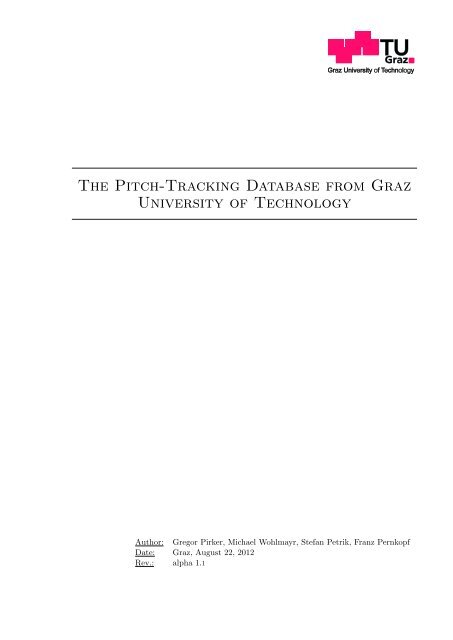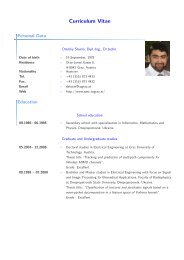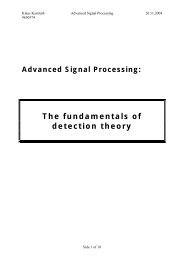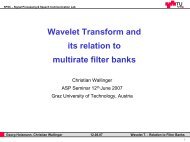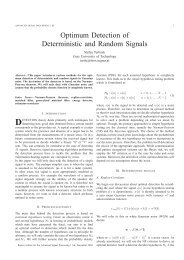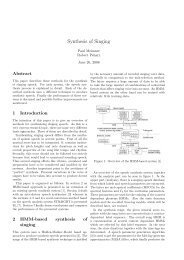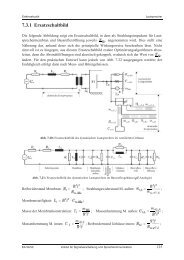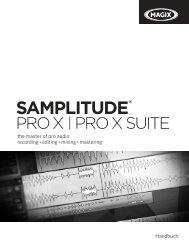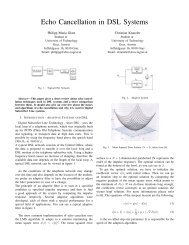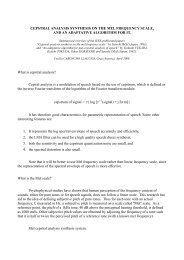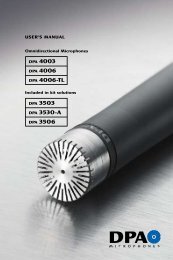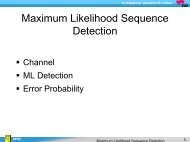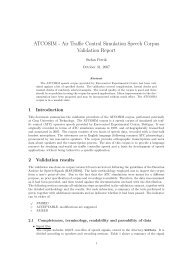Contents - SPSC - Graz University of Technology
Contents - SPSC - Graz University of Technology
Contents - SPSC - Graz University of Technology
You also want an ePaper? Increase the reach of your titles
YUMPU automatically turns print PDFs into web optimized ePapers that Google loves.
The Pitch-Tracking Database from <strong>Graz</strong><br />
<strong>University</strong> <strong>of</strong> <strong>Technology</strong><br />
Author: Gregor Pirker, Michael Wohlmayr, Stefan Petrik, Franz Pernkopf<br />
Date: <strong>Graz</strong>, August 22, 2012<br />
Rev.: alpha 1.1
Abstract<br />
The Pitch Tracking Database from <strong>Graz</strong> <strong>University</strong> <strong>of</strong> <strong>Technology</strong> (PTDB-TUG) is a speech<br />
database for pitch tracking that provides microphone and laryngograph signals <strong>of</strong> 20 English<br />
native speakers as well as reference pitch trajectories. Each subject read 236 out <strong>of</strong> 2342 phonetically<br />
rich sentences from the existing TIMIT corpus [2]. The text material was selected such that<br />
each sentence was spoken by at least one female and one male speaker. In total this database<br />
consists <strong>of</strong> 4720 recorded utterances. All recordings were carried out on-site at the recording<br />
studio <strong>of</strong> the Institute <strong>of</strong> Broadband Communications at <strong>Graz</strong> <strong>University</strong> <strong>of</strong> <strong>Technology</strong>. In this<br />
report an exposition <strong>of</strong> all the properties and a description <strong>of</strong> the main steps <strong>of</strong> production are<br />
presented.
Gregor Pirker, Michael Wohlmayr, Stefan Petrik, Franz Pernkopf PTDB-TUG<br />
<strong>Contents</strong><br />
1 Introduction 4<br />
2 Specifications 5<br />
3 Speaker Pr<strong>of</strong>iles 6<br />
4 Spoken Content 7<br />
5 Corpus Structure and Terminology 8<br />
5.1 Structure . . . . . . . . . . . . . . . . . . . . . . . . . . . . . . . . . . . . . . . 8<br />
5.2 Terminology . . . . . . . . . . . . . . . . . . . . . . . . . . . . . . . . . . . . . 9<br />
6 Data Recording 10<br />
6.1 Acoustical Environment . . . . . . . . . . . . . . . . . . . . . . . . . . . . . . . 10<br />
6.2 Recording procedure . . . . . . . . . . . . . . . . . . . . . . . . . . . . . . . . . 11<br />
6.3 Technical Setup . . . . . . . . . . . . . . . . . . . . . . . . . . . . . . . . . . . 11<br />
7 Post-processing 12<br />
7.1 Microphone and Laryngograph Signals . . . . . . . . . . . . . . . . . . . . . . . 12<br />
7.2 Reference Signals . . . . . . . . . . . . . . . . . . . . . . . . . . . . . . . . . . . 12<br />
8 Conclusion 14<br />
Rev.: alpha 1.1 DRAFT, August 22, 2012 – 3 –
Gregor Pirker, Michael Wohlmayr, Stefan Petrik, Franz Pernkopf PTDB-TUG<br />
1 Introduction<br />
A pitch tracking algorithm usually estimates the pitch or the fundamental frequency <strong>of</strong> human<br />
speech or music signals. The Signal Processing and Speech Communication (<strong>SPSC</strong>) Laboratory<br />
at <strong>Graz</strong> <strong>University</strong> <strong>of</strong> <strong>Technology</strong> developed such an algorithm for multiple speakers talking<br />
simultaneously [4] [5]. In the course <strong>of</strong> advancement this multi pitch tracker had to be evaluated<br />
and compared to similar algorithms by means <strong>of</strong> proper speech data. In order to achieve<br />
both, sufficient speaker dependent and speaker independent modelling, this data had to meet<br />
the following requirements:<br />
• a substantial amount <strong>of</strong> speech data composed <strong>of</strong> phonetically rich sentences that allows<br />
for meaningful training <strong>of</strong> speaker-dependent models and<br />
• a variety <strong>of</strong> female and male speakers such that a multi-pitch tracker can be evaluated<br />
seriously.<br />
Since no existing database fulfilled our requirements, it was a consequent step to produce the<br />
PTDB-TUG (Pitch Tracking Database from <strong>Graz</strong> <strong>University</strong> <strong>of</strong> <strong>Technology</strong>). This database is<br />
provided on the website <strong>of</strong> the <strong>SPSC</strong> Laboratory at <strong>Graz</strong> <strong>University</strong> <strong>of</strong> <strong>Technology</strong> for research<br />
purposes in the area <strong>of</strong> speech analysis and pitch tracking. Evaluation results <strong>of</strong> the multi<br />
pitch tracker can be found in [7]. The PTDB-TUG includes signals recorded from microphone,<br />
which are supposed to be the data for algorithm testing. One can use either the provided<br />
reference signals or extract own ground truth data from the laryngograph signals if desired. At<br />
the beginning <strong>of</strong> this report the specifications <strong>of</strong> the final speech corpus are introduced. After<br />
that a closer look is taken to the pr<strong>of</strong>iles <strong>of</strong> the participants as well as to the spoken content,<br />
which was taken from [2]. The further sections deal with the collection <strong>of</strong> the microphone<br />
and laryngograph data and with the required post processing steps, which primarily means the<br />
extraction <strong>of</strong> the reference pitch signals. In the end an overview <strong>of</strong> the corpus structure and<br />
its terminology is provided. The whole database production process was carried out following<br />
mainly the suggestions from [1].<br />
Rev.: alpha 1.1 DRAFT, August 22, 2012 – 4 –
Gregor Pirker, Michael Wohlmayr, Stefan Petrik, Franz Pernkopf PTDB-TUG<br />
2 Specifications<br />
20 English native speakers, <strong>of</strong> which 10 were female and 10 were male speakers, contributed<br />
to the PTDB-TUG. The text material consists <strong>of</strong> 2342 phonetically rich sentences, which are<br />
taken from the existing TIMIT corpus [2] and were read by both female and male speakers.<br />
All recordings were supervised and carried out on-site at the recording studio <strong>of</strong> the Institute<br />
<strong>of</strong> Broadband Communications at <strong>Graz</strong> <strong>University</strong> <strong>of</strong> <strong>Technology</strong>. The acoustical background<br />
consisted only <strong>of</strong> the fan noise <strong>of</strong> the recording notebook which was located 2m from the head<br />
<strong>of</strong> the speaker and separated by an absorbing wall. The speakers had to read the sentences<br />
from a screen, while being recorded by means <strong>of</strong> a headset microphone and a laryngograph<br />
simultaneously. Both, microphone signals and laryngograph signals were recorded at 48 kHz<br />
sampling rate, 16 bits resolution, with the type <strong>of</strong> encoding signed PCM and the byte order<br />
type little endian. Two channels were recorded in one stereo WAV file. The left channel was<br />
used for the microphone, the right channel for the laryngograph. The final database provides<br />
both microphone signals and laryngograph signals as single-channel WAV files. For the reference<br />
pitch data the output file <strong>of</strong> the RAPT pitch tracking algorithm [6] - an ASCII format file with<br />
the extension ’.f0’ - is used. This file contains a four column matrix which includes the pitch,<br />
a voicing decision, the root mean square values and the peak-normalized autocorrelation values<br />
respectively. In addition, the database provides some text files with meta data like the recording<br />
protocol, the speaker pr<strong>of</strong>iles and a list <strong>of</strong> the TIMIT prompts.<br />
Rev.: alpha 1.1 DRAFT, August 22, 2012 – 5 –
Gregor Pirker, Michael Wohlmayr, Stefan Petrik, Franz Pernkopf PTDB-TUG<br />
3 Speaker Pr<strong>of</strong>iles<br />
For cooperation and comparison with international research, in particular in the area <strong>of</strong> pitch<br />
tracking, the main requirement for the participating persons was to be an English native speaker.<br />
The subjects were recruited by means <strong>of</strong> postings to newsgroups and advertisements at appropriate<br />
institutions and associations as well as word-<strong>of</strong>-mouth recommendations. Each speaker<br />
was informed about the purpose <strong>of</strong> the recording, data protection and anonymity and had to<br />
sign a declaration <strong>of</strong> allowance, in order to enable us to use the recordings and some insensible<br />
data in the database. 20 English native speakers from five different countries contributed to<br />
the database. The gender distribution is 50:50, the age varies from 22 to 48 years. Table 3.1<br />
provides the complete speaker pr<strong>of</strong>iles.<br />
Speaker<br />
ID<br />
Age Sex Home<br />
Country<br />
Sentences Comment<br />
F01 40 Female Ireland sa1,2 sx3-47 si453-641<br />
F02 25 Female USA sa1,2 sx48-92 si642-830<br />
F03 22 Female Canada sa1,2 sx93-137 si831-1019<br />
F04 26 Female Canada sa1,2 sx138-182 si1020-1208<br />
F05 48 Female USA sa1,2 sx183-227 si1209-1397<br />
F06 28 Female USA sa1,2 sx228-272 si1398-1586<br />
F07 24 Female USA sa1,2 sx273-317 si1587-1775<br />
F08 22 Female England sa1,2 sx318-362 si1776-1964 Error: si1912,1913<br />
F09 22 Female USA sa1,2 sx363-407 si1965-2153<br />
F10 35 Female USA sa1,2 sx408-452 si2154-2342<br />
M01 24 Male South Africa sa1,2 sx3-47 si453-641<br />
M02 40 Male England sa1,2 sx48-92 si642-830<br />
M03 35 Male England sa1,2 sx93-137 si831-1019<br />
M04 26 Male USA sa1,2 sx138-182 si1020-1208<br />
M05 25 Male England sa1,2 sx183-227 si1209-1397<br />
M06 23 Male USA sa1,2 sx228-272 si1398-1586<br />
M07 24 Male USA sa1,2 sx273-317 si1587-1775<br />
M08 24 Male England sa1,2 sx318-362 si1776-1964<br />
M09 24 Male Canada sa1,2 sx363-407 si1965-2153<br />
M10 33 Male USA sa1,2 sx408-452 si2154-2342<br />
Table 3.1: Speaker Pr<strong>of</strong>iles<br />
Note: In the course <strong>of</strong> data collection an error occurred. Hence the indicated sentences are not<br />
available.<br />
Rev.: alpha 1.1 DRAFT, August 22, 2012 – 6 –
Gregor Pirker, Michael Wohlmayr, Stefan Petrik, Franz Pernkopf PTDB-TUG<br />
4 Spoken Content<br />
As text material the sentences from the existing TIMIT corpus, which is intended to be used in<br />
speech research purposes, were taken. In these prompts three different types <strong>of</strong> phonetically rich<br />
sentences can be found: There are two dialect sentences to expose the dialectal variants <strong>of</strong> the<br />
speakers, 450 phonetically-compact sentences to provide a good coverage <strong>of</strong> pairs <strong>of</strong> phones with<br />
extra occurrences <strong>of</strong> phonetic contexts, thought to be either difficult or <strong>of</strong> particular interest,<br />
and 1890 phonetically-diverse sentences to add diversity in sentence types and phonetic contexts.<br />
A detailed description can be found in [2]. Table 4.1 shows the sentence labeling <strong>of</strong> the TIMIT<br />
prompts.<br />
Sentence Type Labeling<br />
dialect sentences sa[sentence number out <strong>of</strong> {1,2}]<br />
phonetically-compact s. sx[sentence number out <strong>of</strong> {3,4,5,... ,451,452}]<br />
phonetically-diverse si[sentence number out <strong>of</strong> {453,454,455,... ,2341,2342}]<br />
Table 4.1: The sentence labeling <strong>of</strong> the TIMIT prompts<br />
Sentence examples:<br />
Dialect sentence (sa1): She had your dark suit in greasy wash water all year.<br />
Phonetically-compact sentence (sx409): Eating spinach nightly increases strength miraculously.<br />
Phonetically-diverse sentence (si1291): They should live in modest circumstances, avoiding all<br />
conspicuous consumption.<br />
Table 4.2 illustrates the distribution <strong>of</strong> sentences among speakers in the PTDB-TUG: The<br />
two dialect sentences were read by all 20 speakers. Additionally each speaker read 45 <strong>of</strong> the<br />
phonetically-compact sentences and 189 <strong>of</strong> the phonetically-diverse sentences. Hence each <strong>of</strong><br />
these sentences was spoken by two different speakers, once by a female and another time by<br />
a male speaker. The mapping <strong>of</strong> the speaker ID to the corresponding part <strong>of</strong> sentences is included<br />
in Table 1 and can also be found in SPEAKER-PROFILES.TXT in the documentation<br />
directory.<br />
Sentence Type #Sentences #Speakers Total #Sentences/Speaker<br />
Dialect sentences (sa) 2 20 40 2<br />
Phonetically-compact s. (sa) 450 2 900 45<br />
Phonetically-diverse s. (si) 1890 2 3780 189<br />
Total 2342 4720 236<br />
Table 4.2: Distribution <strong>of</strong> the three types <strong>of</strong> phonetically rich sentences<br />
Rev.: alpha 1.1 DRAFT, August 22, 2012 – 7 –
Gregor Pirker, Michael Wohlmayr, Stefan Petrik, Franz Pernkopf PTDB-TUG<br />
5 Corpus Structure and Terminology<br />
5.1 Structure<br />
Figure 5.1: Database structure<br />
According to figure 5.1 the PTDB-TUG consists <strong>of</strong> two subdirectories containing the documentation<br />
and the speech data. The speech signal files are separated into female data and male<br />
data in the first place and into microphone signals, laryngograph signals and reference signals<br />
in the second place. In each <strong>of</strong> these three directories one can find folders labeled according to<br />
the speaker IDs which contain corresponding data.<br />
In the documentation directory beside this PDF the following files are available: RECORDING-<br />
PROTOCOL.TXT, SPEAKER-PROFILES.TXT and TIMIT-PROMTS.TXT.<br />
One can choose between female and male data based on the same spoken content. Both directories,<br />
FEMALE and MALE, provide three signal categories:<br />
MIC: Signals recorded by microphone<br />
Lar: Signals recorded by laryngograph<br />
Ref: Extracted reference pitch trajectories<br />
Rev.: alpha 1.1 DRAFT, August 22, 2012 – 8 –
Gregor Pirker, Michael Wohlmayr, Stefan Petrik, Franz Pernkopf PTDB-TUG<br />
5.2 Terminology<br />
Table 5.1 provides an overview <strong>of</strong> the database’s terminology.<br />
Recording ID [Data category]_[ Speaker ID]_[Sentence ID]<br />
Data category mic . . . microphone signal<br />
lar . . . laryngograph signal<br />
ref . . . reference pitch trajectory<br />
Speaker ID [Sex][Speaker number]<br />
Sex F . . . female, M . . . male<br />
Sentence ID adopted from the TIMIT prompts according to Table 4.1<br />
Table 5.1: Terminology <strong>of</strong> the PTDB-TUG<br />
For instance mic_F04_sa2.wav is a WAV file providing sentence sa2 read by speaker F04 and<br />
recorded by microphone. Speaker F04 is the female speaker number four.<br />
Rev.: alpha 1.1 DRAFT, August 22, 2012 – 9 –
Gregor Pirker, Michael Wohlmayr, Stefan Petrik, Franz Pernkopf PTDB-TUG<br />
6 Data Recording<br />
6.1 Acoustical Environment<br />
In order to produce high quality signals in a defined acoustical environment with the possibility<br />
to control and modify this process immediately, the appropriate setup for this speech corpus<br />
production had to be a supervised on-site recording in a recording studio. Consequently, all<br />
recordings were done in the recording studio at the Institute <strong>of</strong> Broadband Communications<br />
at <strong>Graz</strong> <strong>University</strong> <strong>of</strong> <strong>Technology</strong>. Figure 5.1 shows the recording setup: Both, the speaker<br />
and the supervisor were sitting in the recording room and were looking at their own screen.<br />
The supervisor controlled and monitored the recording procedure with the help <strong>of</strong> the recording<br />
s<strong>of</strong>tware SpeechRecorder [3] and headphones. The speaker was equipped with the headset<br />
microphone and the neck band with the laryngograph electrodes and had to read the displayed<br />
sentence. To reduce the background noise from the recording laptop, the supervisor position<br />
was separated by an absorbing wall from the speaker.<br />
Figure 6.1: Recording Setup<br />
Rev.: alpha 1.1 DRAFT, August 22, 2012 – 10 –
Gregor Pirker, Michael Wohlmayr, Stefan Petrik, Franz Pernkopf PTDB-TUG<br />
6.2 Recording procedure<br />
Special attention was paid on the placement and the distance <strong>of</strong> the headset as well as on<br />
the position <strong>of</strong> the laryngograph electrodes. The headset microphone had to be at a distance <strong>of</strong><br />
about one or two cm from the speakers corner <strong>of</strong> the mouth. The right position for the electrodes<br />
<strong>of</strong> the laryngograph is on either side <strong>of</strong> the larynx. Before starting the received signals were<br />
adjusted and tested by means <strong>of</strong> some extra sentences. No special instructions were given to<br />
the probands except for having to read the displayed sentences. The recordings were made with<br />
the help <strong>of</strong> the particular speech recording program SpeechRecorder [3] and were carried out<br />
sentence by sentence, so that repetitions in case <strong>of</strong> reading mistakes or technical problems such<br />
as signal clipping could be done easily. According to the recording phases in [3] each utterance<br />
was recorded with a predelay <strong>of</strong> 2000 ms to give the speaker a certain time to get prepared and<br />
a postdelay <strong>of</strong> 500 ms to avoid signal truncation due to stopping the recording too early. The<br />
whole recording session took about an hour and contained breaks if desired by the participants.<br />
6.3 Technical Setup<br />
For this recording task an IBM laptop, type 2366, equipped with the program SpeechRecorder [3]<br />
as well as the firewire recording interface Presonus Firebox was used. All microphone signals were<br />
recorded by means <strong>of</strong> an AKG HC 577 L condenser headset microphone with omni-directional<br />
pickup pattern. Additionally, the vocal folds vibration was detected by a so-called Portable<br />
Laryngograph®.<br />
Rev.: alpha 1.1 DRAFT, August 22, 2012 – 11 –
Gregor Pirker, Michael Wohlmayr, Stefan Petrik, Franz Pernkopf PTDB-TUG<br />
7 Post-processing<br />
7.1 Microphone and Laryngograph Signals<br />
The provided microphone and laryngograph signals in this database were digitized at 48 kHz<br />
and 16 bit resolution. The two signal types were recorded in stereo wav-files. The left channel<br />
was used for the microphone, the right channel for the laryngograph. Later on, the channels<br />
were extracted into mono wav-files and renamed. No further post-processing (cutting, filtering,<br />
. . . ) was carried out on this data.<br />
7.2 Reference Signals<br />
The reference pitch trajectories, which are provided as ground truth data, were extracted out <strong>of</strong><br />
the laryngograph waveforms. In general, a laryngograph signal recorded during voiced speech<br />
shows a quasi-periodic shape that represents the vocal folds vibration. Additionally, a lower<br />
frequency component is superimposed on this shape, which is mainly caused by larynx movement.<br />
Before pitch extraction can be carried out, this part has to be removed by a high pass filter to<br />
reduce pitch candidates, that deviate from the true pitch trajectory (outliers). Filtering was<br />
carried out in Matlab by applying a linear phase Kaiser filter with parameters β = 0,5 and n<br />
= 2400 to the rough laryngograph signals. For each gender group one specific cut-<strong>of</strong>f frequency<br />
fc was used. For the female speaker signals the cut-<strong>of</strong>f frequency was fc = 25Hz, for the male<br />
fc = 15Hz. Finally, the RAPT algorithm [6] was run on the filtered laryngograph signals to<br />
extract the pitch. The RAPT algorithm is implemented in Wavesurfer [8] and can be applied to<br />
multiple wave-files in batch mode using a scripting language called the snack sound toolkit [9].<br />
The output <strong>of</strong> RAPT provides 4 measures per time frame:<br />
1st column: the pitch estimate [Hz]<br />
2nd column: probability <strong>of</strong> voicing<br />
3rd column: local root mean squared estimate (RMSE)<br />
4rd column: value <strong>of</strong> peak normalized cross-correlation value that was detected and used to<br />
determine the pitch estimate.<br />
The reference pitch was extracted using a 32ms analysis window with 10ms hopsize. Depending<br />
on the application, the user might want to extract the pitch with different settings for the<br />
analysis window. This can be done quite easily with [9] as follows<br />
Rev.: alpha 1.1 DRAFT, August 22, 2012 – 12 –
Gregor Pirker, Michael Wohlmayr, Stefan Petrik, Franz Pernkopf PTDB-TUG<br />
We used the following script (extractPitch.tcl) for pitch extraction:<br />
1 #!/ bin /sh<br />
2 # the next line restarts using wish \<br />
3 exec wish8.4 "$0" "$@"<br />
4<br />
5 package require snack<br />
6<br />
7 snack::sound s<br />
8<br />
9 foreach file $argv {<br />
10 s read $file<br />
11<br />
12 set fd [ open [ file rootname $file ] .f0 w]<br />
13 puts $fd [ join [s pitch -method esps -windowlength 0 .032 -framelength 0 .01 ] \n]<br />
14 close $fd<br />
15 }<br />
16<br />
17 exit<br />
Listing 7.1: extractPitch.tcl: tcl script for pitch extraction using the RAPT algorithm.<br />
Assuming you have installed tcl (tool command language) (see [9] for details), you can then<br />
apply RAPT from your shell on multiple wave files:<br />
>> tclsh extractPitch.tcl *.wav<br />
where the script (see listing 7.1) as well as all wave files are assumed to be located in the current<br />
working directory. The user can set a different window length or hopsize in line 13.<br />
Rev.: alpha 1.1 DRAFT, August 22, 2012 – 13 –
Gregor Pirker, Michael Wohlmayr, Stefan Petrik, Franz Pernkopf PTDB-TUG<br />
8 Conclusion<br />
This report introduced the pitch tracking database PTDB-TUG produced at <strong>Graz</strong> <strong>University</strong><br />
<strong>of</strong> <strong>Technology</strong>. The database consists <strong>of</strong> microphone and laryngograph recordings <strong>of</strong> 10 female<br />
and 10 male speakers, who had to read 2342 phonetically rich sentences. The spoken language<br />
<strong>of</strong> this corpus is English. In addition to the recordings, the corresponding ground truth pitch<br />
signals are provided. This report also describes the production process including the recording<br />
and the subsequent signal processing, concerning mainly the reference pitch trajectories. The<br />
PTDB-TUG is the first <strong>of</strong> its kind that contains a large number <strong>of</strong> subjects speaking a great<br />
number <strong>of</strong> different utterances. For research purposes, the database can be downloaded from<br />
the website <strong>of</strong> the <strong>SPSC</strong> Laboratory at <strong>Graz</strong> <strong>University</strong> <strong>of</strong> <strong>Technology</strong>.<br />
Rev.: alpha 1.1 DRAFT, August 22, 2012 – 14 –
Gregor Pirker, Michael Wohlmayr, Stefan Petrik, Franz Pernkopf PTDB-TUG<br />
Bibliography<br />
[1] Schiel F., Draxler Ch.: “Production and Validation <strong>of</strong> Speech Corpora,” Bastard Verlag,<br />
München, 2003<br />
[2] J.S. Gar<strong>of</strong>olo, L.F. Lamel, W.M. Fisher, J.G. Fiscus, D.S. Pallett and N.L. Dahlgren,<br />
“The DARPA TIMIT acoustic-phonetic continuous speech corpus CDROM,” NTIS, order<br />
number PB01-100354, 1993, now available from LDC.<br />
[3] C. Draxler, “Speech recorder quick start and user manual,” Institute <strong>of</strong> Phonetics and<br />
Speech Processing, <strong>University</strong> <strong>of</strong> Munich, Tech. Rep. www.speechrecorder.org, 2011.<br />
[4] M. Wohlmayr, M. Stark, and F. Pernkopf, “A probabilistic interaction model for multipitch<br />
tracking with factorial hiddenMarkov models,” IEEE Transactions on Audio, Speech, and<br />
Language Processing, vol. 19, no. 4, pp. 799-810, 2011.<br />
[5] M. Wohlmayr, R. Peharz, and F. Pernkopf, “Efficient implementation <strong>of</strong> probabilistic multipitch<br />
tracking,” in IEEE International Conference on Acoustics, Speech, and Signal Processing<br />
(ICASSP), 2011.<br />
[6] D. Talkin, “A robust algorithm for pitch tracking (RAPT),” Speech Coding and Synthesis,<br />
W. B. Kleijn and K. K. Paliwal, Eds., pp. 495-518, 1995.<br />
[7] G. Pirker, M. Wohlmayr, S. Petrik and F. Pernkopf, “A Pitch Tracking Corpus with Evaluation<br />
on Multipitch Tracking Scenario,” in Interspeech, 2011.<br />
[8] http://www.speech.kth.se/wavesurfer/<br />
[9] http://www.speech.kth.se/snack/<br />
Rev.: alpha 1.1 DRAFT, August 22, 2012 – 15 –


